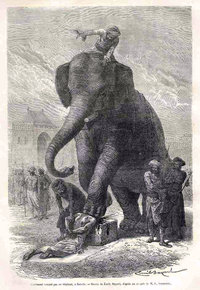Crushing by elephant
|
|
Crushed_by_elephant.png
Crushing by elephant was a common sentence for those condemned to death throughout south and southeast Asia, particularly India, for over 4,000 years. The Romans and Carthaginians also used this method on occasions, and it is mentioned by Josephus and the deuterocanonical book of 3 Maccabees in connection with the Egyptians.
For many centuries elephants were also used for military purposes, and death under the foot of an elephant was commonplace for deserters or prisoners as well as for military criminals.
The English sailor Robert Knox, writing in 1681, described a method of execution by elephant which he had seen while being held captive in Sri Lanka:
- The King makes use of them for Executioners; they will run their Teeth through the body, and then taer it in pieces, and throw it limb from limb. They have sharp Iron with a socket with three edges, which they put on their Teeth at such times...
(An Historical Relation of the Island Ceylon [1] (http://www.gutenberg.org/etext/14346), Robert Knox, London, 1681)
During an expedition to central India in 1868, Mr. Louis Rousselet described the execution of a criminal by elephant. A sketch was made of the execution showing the condemned being forced to place his head upon a pedestal, and then being held there while an elephant crushed his head underfoot. The sketch was made into a woodcut and printed in "Le Tour du Monde", a widely circulated French journal of travel and adventure.
Occasionally, executions would be prolonged either by having the elephant drag the condemned through the streets before the execution (usually by a rope attached to the elephant's leg), or through the use of an elephant that was trained to crush limbs first, and then the chest, often with excruciating slowness.
Most rajahs kept elephants for the purpose of execution by crushing. These executions were often held in public as a warning to any who might transgress. To that end, many of the elephants were especially large, often weighing in excess of nine tons. The executions were intended to be gruesome and, by all accounts, they often were.
Some monarchs also adopted this form of execution for their own entertainment. Emperor Jahangir of India's long-running Mughal dynasty ordered a huge number of criminals to be crushed for this purpose, although the Mughals had no monopoly on death by elephant; during the 18th century the rival Marathas confederacy also used this method of execution. The Maratha Sardar Santaji Ghorpade (1764–1794) admitted to a weakness for this particular punishment and, for the slightest error, would order an offender to be crushed beneath the enormous feet of his royal elephant.
Throughout the 18th and 19th centuries, Muslim courts of law in South Asia commonly ordered their condemned to be crushed by elephants. Increased domination by the British Empire led to the decline and eventual end of elephant executions. Death by elephant is still not uncommon in parts of Africa and South Asia where humans and elephants co-exist, but these tend to be the result of wild elephants attacking humans rather than tame elephants being used by humans to kill other humans.
A similar but unrelated term is Elephant "Crushing". It refers to the method of domesticating young elephants. It is seen mainly in Asia and in places where elephants have been domesticated. However in Thailand the process is more ritualised having been practised for centuries. It is a brutal method aimed at "breaking" the Elephant's spirit and has been opposed by animal activists like the PETA.
bs:Gnječenje sa slonom fr:Exécution par éléphant he:מחיצה על ידי פיל simple:Crushing by elephant

